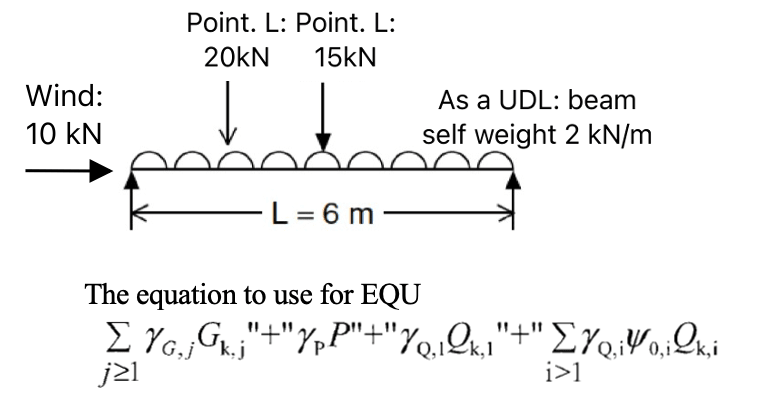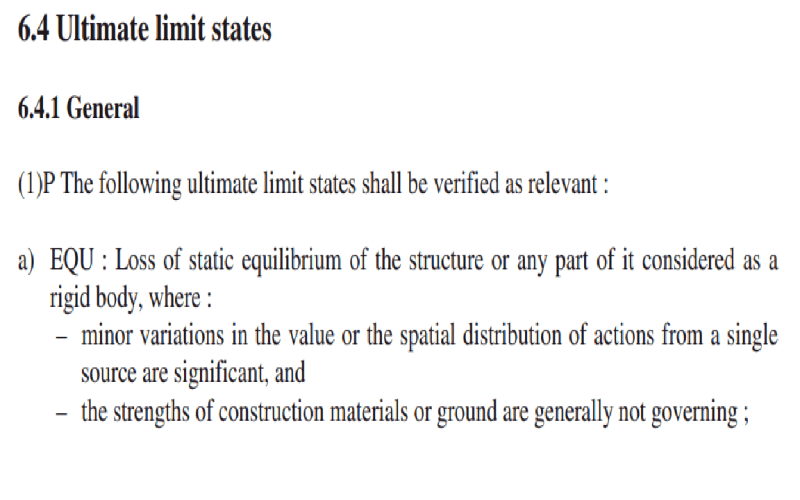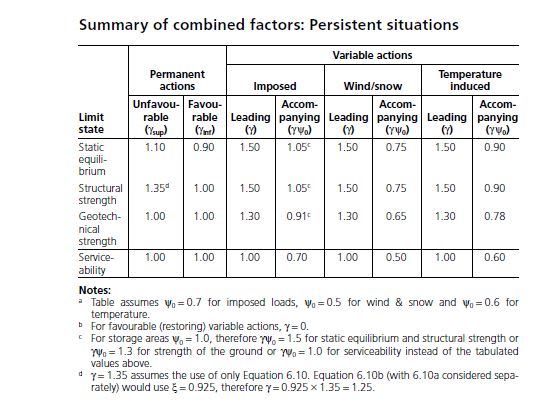Pretty Girl7
Civil/Environmental
I was checking the load combinations and then was trying to check for EQU. (Trying to learn how to do it in real-life situation)
My aim was to find out the loads acting on the beam and find the forces. Feed the forces into EQU equation stated below. Then feed the forces into bending moment equations to design the r/f needed etc.

The equation is from: clause 6.4.3.2, page 47, Eurocode 0.
I did the calculation to find the loads as below, but I don't know where to place the wind load in the equation as it's lateral load. I don't even know if the above equilibrium equation is supposed to have wind loads as well.
combination 1: (Self weight) + (1.5 x PL1) + (1.5 x 0.7 x PL2) + WIND LOAD
Ed = (1.35 x (2 kN/m x 6)) + (1.5 x 15 kN) + (1.5 x 0.7 x 20 kN) + WIND LOAD
Ed = 16.2 kN + 22.5 kN + 21 kN + WIND LOAD
Ed = 61.95 kN + WIND LOAD
Then I calculated total moments, but since I don't know where to put "wind load" in above equation, I didn't include it.
Total moments (MEd) = (Design load x length) / 8 + (Design load x length) / 4
= "(16.2kN x 6 m) / 8" + "(22.5kN x 6 m) / 4" + "(21kN x 6 m) / 4"
= 9 kN + 33.75 kN + 31.5 kN
= 77.40 kNm
I have mainly two questions.
1. How to include lateral wind load into that equation.
2. Is the calculation correct if we consider the wind-load didn't exist.
My aim was to find out the loads acting on the beam and find the forces. Feed the forces into EQU equation stated below. Then feed the forces into bending moment equations to design the r/f needed etc.

The equation is from: clause 6.4.3.2, page 47, Eurocode 0.
I did the calculation to find the loads as below, but I don't know where to place the wind load in the equation as it's lateral load. I don't even know if the above equilibrium equation is supposed to have wind loads as well.
combination 1: (Self weight) + (1.5 x PL1) + (1.5 x 0.7 x PL2) + WIND LOAD
Ed = (1.35 x (2 kN/m x 6)) + (1.5 x 15 kN) + (1.5 x 0.7 x 20 kN) + WIND LOAD
Ed = 16.2 kN + 22.5 kN + 21 kN + WIND LOAD
Ed = 61.95 kN + WIND LOAD
Then I calculated total moments, but since I don't know where to put "wind load" in above equation, I didn't include it.
Total moments (MEd) = (Design load x length) / 8 + (Design load x length) / 4
= "(16.2kN x 6 m) / 8" + "(22.5kN x 6 m) / 4" + "(21kN x 6 m) / 4"
= 9 kN + 33.75 kN + 31.5 kN
= 77.40 kNm
I have mainly two questions.
1. How to include lateral wind load into that equation.
2. Is the calculation correct if we consider the wind-load didn't exist.

![[smile] [smile] [smile]](/data/assets/smilies/smile.gif) . What is the purpose of all these questions? Trying to learn the Eurocode by asking questions on an Internet forum seems .......
. What is the purpose of all these questions? Trying to learn the Eurocode by asking questions on an Internet forum seems .......
